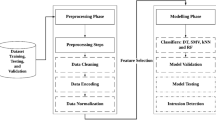Abstract
With the development of industrial Internet of Things technology, the relatively closed industrial control system has become more complex and open, and it is facing increasingly serious information security problems. Aiming at the security problems existing in the current intelligent manufacturing industrial Internet of Things, this paper proposes a credible overall architecture of the IoT industrial control system. By adding a trusted function module, the credibility level is evaluated and abnormal operations are monitored. The sensing environment for the Internet of Things is more complicated. This paper proposes a cluster-based routing method. While ensuring the trustworthiness and security of data routing, the routing protocol is maintained efficiently and reliably. A scenario of node cooperation is proposed for scenarios of a large number of malicious nodes. Abnormal attacks are suppressed by maintaining dynamic Bayesian balance between the attacker and the detection node. The simulation results show that the mechanism cooperation game can significantly improve the event detection success rate of abnormal detection nodes and greatly reduce the number of forged reports.













Similar content being viewed by others
References
Pinto S, Gomes T, Pereira J et al (2017) IIoTEED: an enhanced, trusted execution environment for industrial IoT edge devices. IEEE Internet Comput 21(1):40–47
Ouyang Z, Sun X, Chen J et al (2018) Multi-view stacking ensemble for power consumption anomaly detection in the context of industrial Internet of Things. IEEE Access 6:9623–9631
Wang H, Chen Z, Zhao J et al (2018) A vulnerability assessment method in industrial Internet of Things based on attack graph and maximum flow. IEEE Access 6(99):8599–8609
Qiang L, Xuan F, Wang H et al (2018) Understanding the usage of industrial control system devices on the Internet. IEEE Internet Things J 5(3):2178–2189
Antonini M, Vecchio M, Antonelli F et al (2019) Smart audio sensors in the Internet of Things edge for anomaly detection. IEEE Access 6(99):67594–67610
Wang X, Luo G, Ling T (2017) Application of hyperspectral image anomaly detection algorithm for Internet of things. Multimed Tools Appl 78:2):1–2)13
Deng X, Yang LT, Yi L et al (2018) Detecting confident information coverage holes in industrial Internet of Things: an energy-efficient perspective. IEEE Commun Mag 56(9):68–73
Williams JM, Khanna R, Ruiz-Rosero JP et al (2017) Weaving the wireless web: toward a low-power, dense wireless sensor network for the industrial IoT. IEEE Microw Mag 18(7):40–63
Kleinmann A, Wool A (2017) Automatic construction of statechart-based anomaly detection models for multi-threaded industrial control systems. ACM Trans Intell Syst Technol 8(4):1–21
Zhao G, Liu YJ, Shi Y (2018) Real-time assessment of the cross-task mental workload using physiological measures during anomaly detection. IEEE Trans Human-Machine Syst 48(2):1–12
Zhou C, Shuang H, Xiong N et al (2017) Design and analysis of multimodel-based anomaly intrusion detection systems in industrial process automation. IEEE Trans Syst Man Cybern Syst 45(10):1345–1360
Ratre A, Pankajakshan V (2018) Tucker tensor decomposition-based tracking and Gaussian mixture model for anomaly localisation and detection in surveillance videos. IET Comput Vis 12(6):933–940
Gitinavard H, Mousavi SM, Vahdani B (2017) Soft computing-based new interval-valued hesitant fuzzy multi-criteria group assessment method with last aggregation to industrial decision problems. Soft Comput 21(12):1–19
Pace P, Aloi G, Gravina R et al (2019) An edge-based architecture to support efficient applications for healthcare Industry 4.0. IEEE Trans Ind Inf 15(1):481–489
Mahmood A, Sisinni E, Guntupalli L et al (2019) Scalability analysis of a LoRa network under imperfect orthogonality. IEEE Trans Ind Inform 15(3):1425–1436
Murillo Y, Reynders B, Chiumento A et al (2019) A multiprotocol low-cost automated testbed for BLE mesh. IEEE Commun Mag 57(3):76–83
Laaki H, Miche Y, Tammi K (2019) Prototyping a digital twin for real time remote control over mobile networks: application of remote surgery. IEEE Access 7(99):20325–20336
Nezami Z, Zamanifar K (2019) Internet of Things/Internet of Everything: structure and ingredients. IEEE Potentials 38(2):12–17
Rakovic V, Karamachoski J, Atanasovski V et al (2019) Blockchain Paradigm and Internet of Things. Wirel Pers Commun 106(3):219–235
Liu S, Guo L, Webb H et al (2019) Internet of Things monitoring system of modern eco-agriculture based on cloud computing. IEEE Access 7(99):37050–37058
Han Y, Seed D, Wang C et al (2019) Delay-aware application protocol for Internet of Things. IEEE Netw 33(1):1–8
Funding
This research was financially supported by the Fundamental Research Funds for Central University: Research on Storing Unstructured Data in the Relational Database Model (Grant No. 2019NQN53).
Author information
Authors and Affiliations
Corresponding author
Additional information
Publisher’s note
Springer Nature remains neutral with regard to jurisdictional claims in published maps and institutional affiliations.
Rights and permissions
About this article
Cite this article
Wang, C. IoT anomaly detection method in intelligent manufacturing industry based on trusted evaluation. Int J Adv Manuf Technol 107, 993–1005 (2020). https://doi.org/10.1007/s00170-019-04274-0
Received:
Accepted:
Published:
Issue Date:
DOI: https://doi.org/10.1007/s00170-019-04274-0




